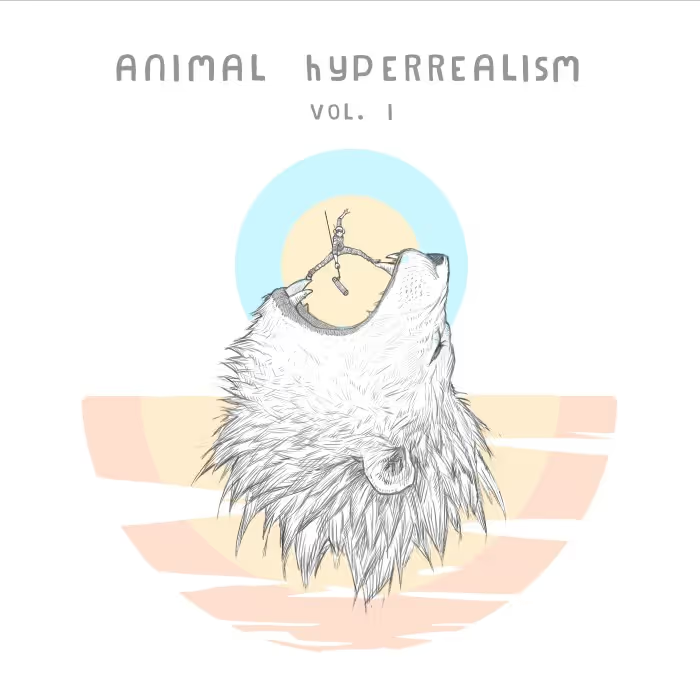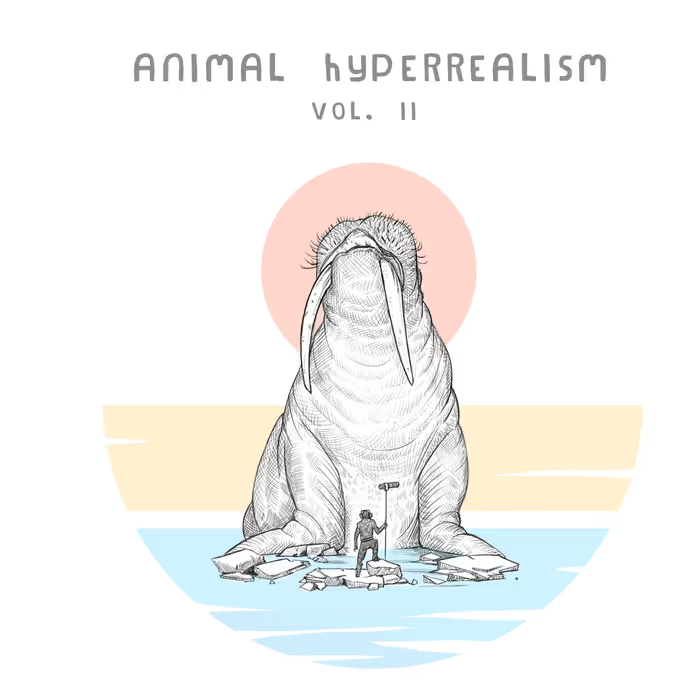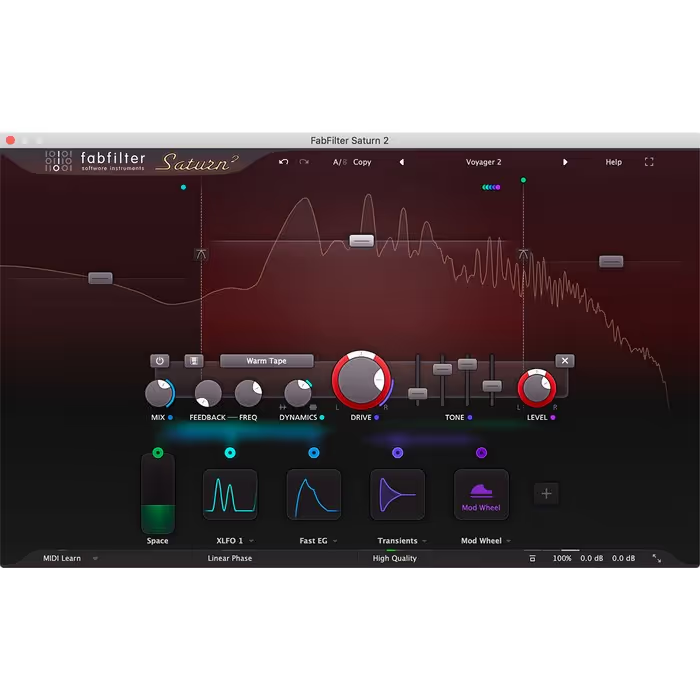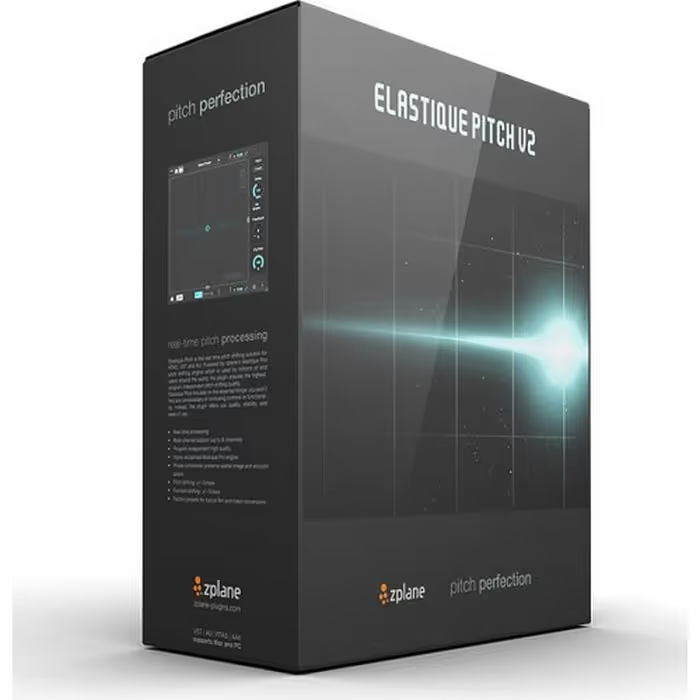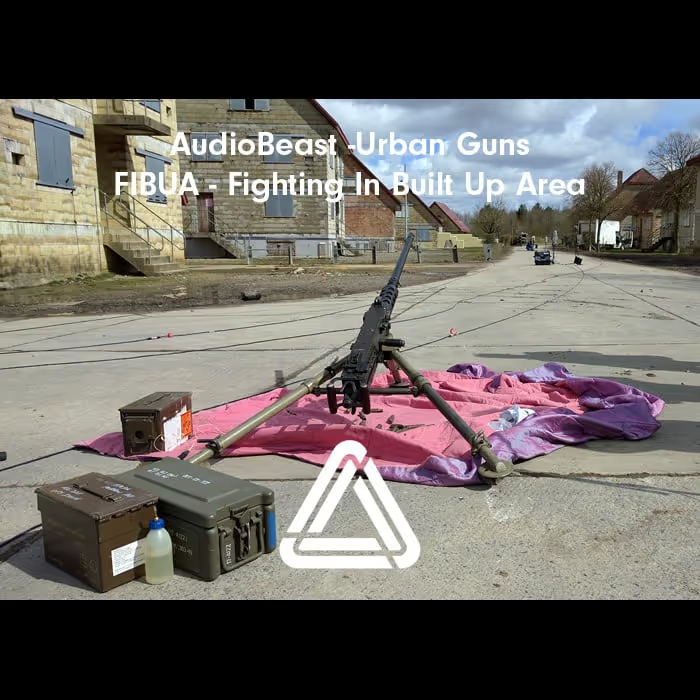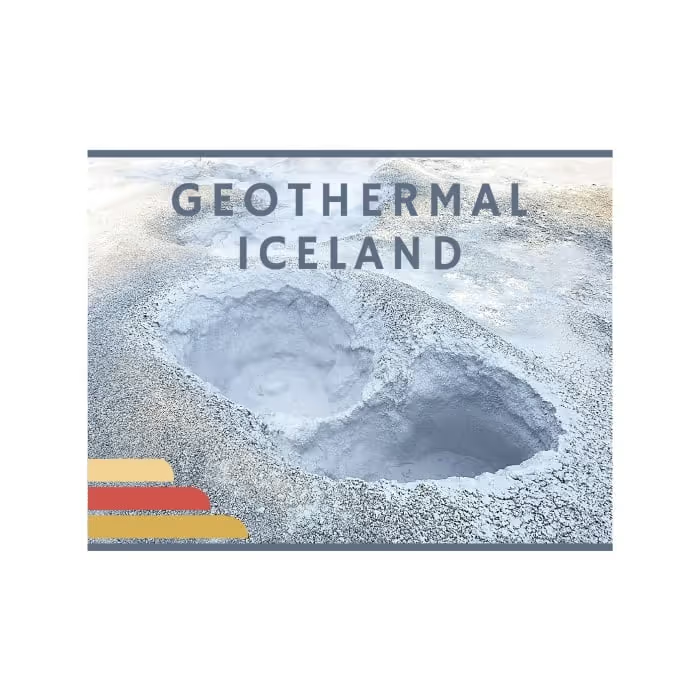With each passing season, the show continues to grow — bigger monsters and bigger emotionality. Here, sound supervisor/designer Craig Henighan and re-recording mixers Will Files and Mark Paterson talk about their approach to growing the show in terms of sound.
Action! Monsters! Comedy! And heart-string-tugging emotional moments that make your eyeballs well up (It’s just an eyelash caught in there, I swear!) This season of Netflix’s Stranger Things culminated in a finale that seemed to have it all and yet the audience is left anticipating Season 4.
Craig Henighan (Sound Designer/Supervising Sound Editor/Re-Recording Mixer), who’s been with the show from the start, is joined this season by Will Files (Supervising Sound Editor/Re-Recording Mixer) and Mark Paterson (Re-Recording Mixer). For Files and Paterson, this wasn’t just their first season of mixing on Stranger Things; it was their first experience of mixing for TV.
Here, Henighan talks about designing the different stages of the Mind Flayer — from a pack of ‘hive-mind’ rats to a massive monster — and how he made their varying range of vocalizations and gore. And Files and Paterson discuss the Duffer brothers’ aesthetic tastes for the final soundtrack, pushing the limits of a television mix, mixing that magical, musical moment when Dustin and Suzie serenade each other with “The Neverending Story” song, and so much more!
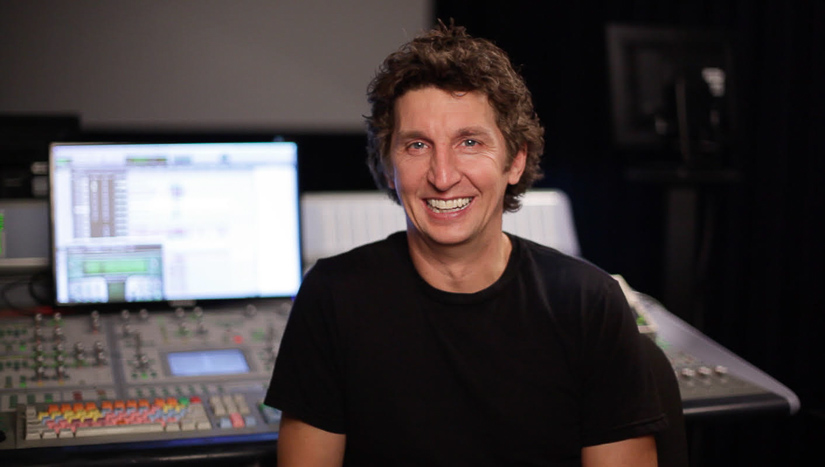
Three seasons already! Wow! Has your approach to the show changed in any way over the years?
Craig Henighan (CH): As you probably have noticed over the course of the seasons, everything has gotten bigger — the scares have gotten bigger, the monsters have gotten bigger, the sets have gotten bigger. So that’s one facet of it.
I remember Matt [Duffer] saying that it was going to be gory and gross and sure enough with the monsters, it was definitely gory and gross!
Back in 2016 when I was brought on board, I wanted to bring more of a cinematic workflow to this show. The Duffer brothers were really open to that. Picture editor Dean Zimmerman was on the first season and back for Season 3 and we’ve worked out a creative workflow over the years.
Season 3 was all about the gore. I remember Matt [Duffer] saying that it was going to be gory and gross and sure enough with the monsters, it was definitely gory and gross! I set about making early ideas for the monsters and for conceptual sound design stuff, getting those sounds to the brothers and into the Avid and letting them live with it. Then we take it from there as the edit evolves.
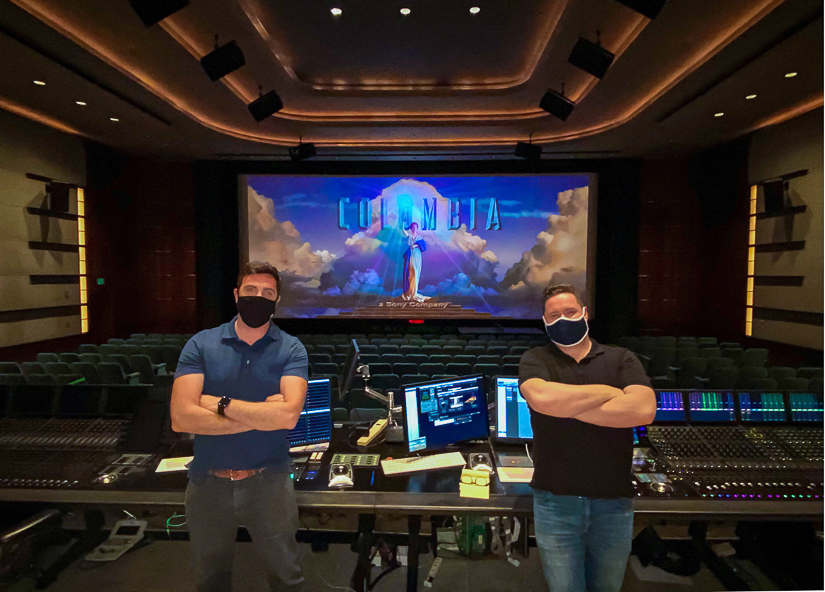
Will and Mark, this was your first season on the show?
Will Files (WF): Yes. And, in fact, it’s the first time that Mark and I have mixed for television. We normally mix feature films.
We had some trepidation going in just because we hadn’t mixed for television before. But other than the schedule being much tighter, we basically approached it the same way we would always approach a mix.
We had some trepidation going in just because we hadn’t mixed for television before.
Mark had to deal with more technical things, like hitting the loudness spec on the dialogue. But from an aesthetic point of view, we approached it the same way we would approach a movie of the same scope and size. We tried to make it as big and cinematic as possible.
We got through the very first scene of the opening of the first episode, and by the time we finished it the Duffer brothers stood up and cheered. At that point we knew we were on the right track.
Mark Paterson (MP): That was a great moment. We played them the first episode and we had no idea what their reaction would be. Their expectations of us were quite high so we felt a lot of pressure. At that point we didn’t know each other very well and we still had to learn the way they liked things to sound. The first playback can sound great but what is more important is that you are telling the story in the correct way.
WF: We were really nervous about it.
MP: We wanted to make sure we delivered for them. So about four minutes into an episode, when they stood up and cheered, we knew we’re doing something right.
We had talked about our approach, to do the big things, the important things first. We didn’t have three months to spend on the stage focusing on each frame. So, we decided to focus on the big things and it ended up being a life lesson for us. Both of us walked away feeling like, “It’s nice to know our instincts are intact. That when we have to do something in a short amount of time we can make the important decisions right.” Then, once we get to that point, everything else’s like icing on the cake.
WF: It was a purely creative process because we didn’t have a lot of time to second-guess ourselves. So we had to go with our first instinct and hope it was right. And 9 times out of 10 it was.
MP: We had a very strong editorial crew. For instance, Ryan Cole the dialogue editor was such a solid editor that I was able to use my short amount of pre-mix time to focus on creative ideas. In every episode, you’ll notice there are 10 to 15 different kinds of stylistic dialogue treatments. Ryan, and the rest of the editorial team, set me up to focus on those things and to be able to explore ideas as opposed to trying to remove clicks and pops from the dialogue, and those more mundane (but necessary) things.
So about four minutes into an episode, when they stood up and cheered, we knew we’re doing something right.
WF: The mix schedule changed as the season went on, because the episodes got longer and bigger. When we started, we had six days for one episode.
MP: But that was for the first presentation. The guys will spend additional time after that to get what they want from the mix. So our initial target is to get something to play them in 6 days knowing that we can spend some additional time developing ideas together.
WF: It was pretty compressed. When we first started, we would split up for the first day to pre-mix alone. I would mix in my studio and Mark would mix on the stage. Then, we’d come together on the second day around lunchtime. We’d put up our material that we mixed separately to get a ballpark shape of it. Then, we had one more day of mixing after that. On the fourth day, we played it back for the producer and got the first round of notes. Then Day 5, we played it for the Duffer brothers. Day 6 we played it for Netflix.
MP: It turns out — after talking with mixers on other shows — that we had quite a luxury schedule.
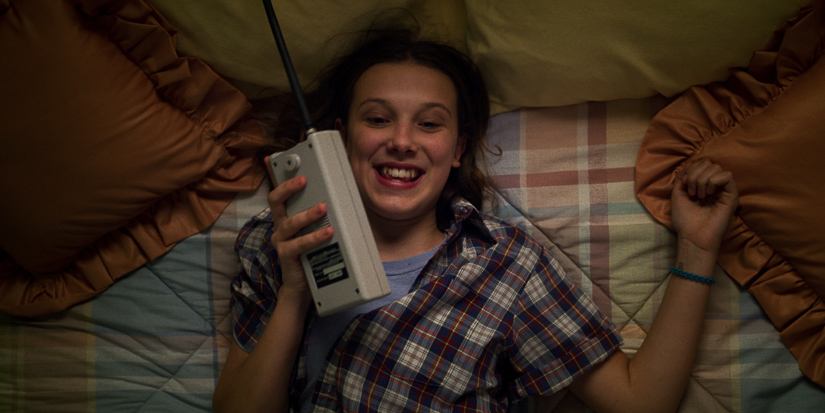
What are the Duffer brothers’ tastes for the mix? What was your guiding light in terms of how you premixed it to get it ready to present to them?
MP: Well the first thing I’d say is that you can’t go too far with any creative idea. Both Matt and Ross encourage creativity in a way that is very rare in my experience.
WF: We learned that very quickly from them.
Both Matt and Ross encourage creativity in a way that is very rare in my experience.
MP: On the first episode, I thought maybe I had gone a bit too far with some of the dialogue treatments. I’ve always tried little stylistic accents on poignant lines of dialogue which I present to directors knowing that not all of them will make it into the final mix. But the Duffers loved every single one and even asked for me to try more. If I had an idea that was cool and tasteful, I was confident they would go for it. It even became an integral part of the way the dialogue sounded in this season. We were allowed to be bold and think outside the box.
WF: And we know how to do that.
Craig [Henighan] was really helpful in regards to setting us up for what the Duffer brothers liked because he has done the last two seasons with them. So he was able to tell us that they like it big, that they want it to be cinematic, and give us feedback in terms of what he thought they would be expecting. That was a super helpful thing to know going in.
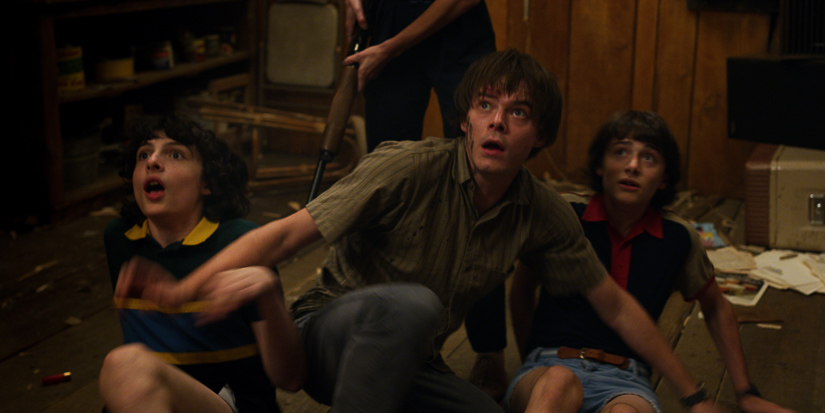
Was this season mixed in 5.1 or Dolby Atmos?
WF: It was 5.1. Although, by the end of the first episode, the Duffer brothers started asking us about Atmos. Maybe we’ll do the next season that way. We’ll see.
It was 5.1. Although, by the end of the first episode, the Duffer brothers started asking us about Atmos.
We certainly would’ve liked to mix it in Atmos. But at a certain point, it comes down to schedule and we didn’t have time to do it.
Somehow the Duffer brothers find a way to make this show even bigger. In Season 3, there were some episodes we watched for the first time and wondered how we were going to get through all of it. It’s massive.
MP: Episode 8 was particularly busy and we had it on our minds from the beginning. As each episode got bigger and bigger we wondered how we would hold our schedule.
WF: And everyone, like the picture editor, kept telling us that we need to prepare ourselves for Ep. 8; that it was a monster!
 Tesla Model X 2015 electric full size crossover SUV sport utility vehicleKrampfstadt Studio65,00 $32,00 $51% OFF
Tesla Model X 2015 electric full size crossover SUV sport utility vehicleKrampfstadt Studio65,00 $32,00 $51% OFF
One of the biggest things this season was the physical manifestation of the Mind Flayer…
CH: Last season he was more behind-the-scenes, but this season he manifested into not one monster but two monsters. The first one was made out of rats to begin with and then human beings.
The first two episodes set the tone for me in terms of how scary the Mind Flayer was and how big of a role it was going to play.
The really big monster we see that shows up in Episode 7 and 8, I didn’t get a peek at him too early. I got a lot of conceptual art about the rats. The first two episodes set the tone for me in terms of how scary the Mind Flayer was and how big of a role it was going to play. I think it was Ep. 1 when we’re in the mall and all the lights go out. Then there’s this great traveling shot over Hawkins and we go into this warehouse; we don’t really see the monster but, with sound, we get to feel it and give a little hint of what’s to come in later episodes.
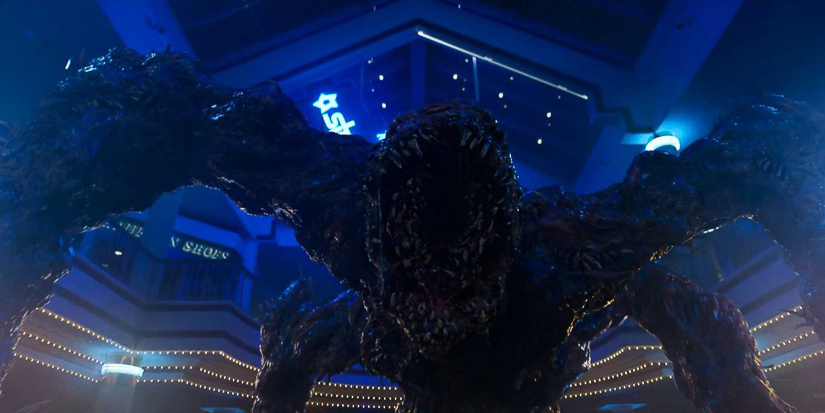
There’s that great scene with the Mind Flayer on top of the mall’s glass ceiling, which cracks and breaks, dropping the monster down inside. What went into your work on that scene?
CH: The whole challenge when he’s on the ceiling was: how do we make it quiet before all hell breaks loose? When Steve is working on the car trying to figure out how to make it start, we’re trying to make that quiet so you can start clueing into the glass breaking slowly overhead. One reference I used for that was The Lost World: Jurassic Park where they’re in the motor home and it’s about to fall over the cliff. You hear the specific ideas of the glass splintering and cracking, slowly amping up until it falls.
I didn’t want to play vocals. I didn’t want to play big monster footsteps and thumps. I wanted it to be a couple of creaks and a few breaks.
If you dissect the Stranger Things scene, there are a lot of similarities to that idea. That was how I started. The monster is up there and he’s creeping up. I didn’t want to play vocals. I didn’t want to play big monster footsteps and thumps. I wanted it to be a couple of creaks and a few breaks. Then, just before they look up you hear one or two footsteps plant and make that heavier sound, to clue everyone to look up.
Then the monster falls through the roof and crashes onto the ground. There’s this big roar and we’re off to the races with this big monster ready to kill everybody.
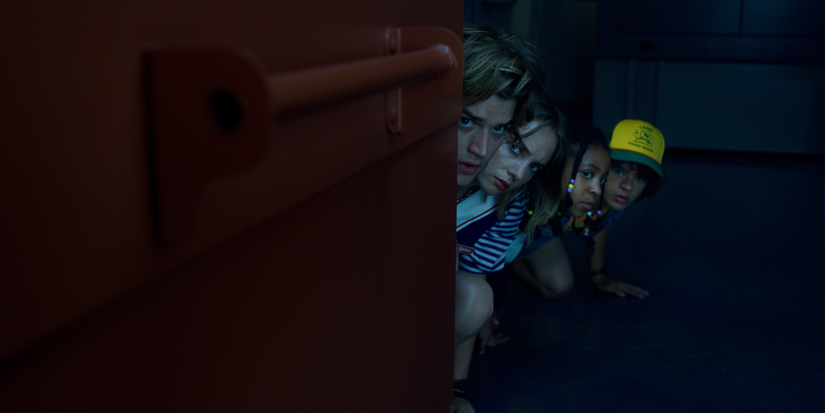
How did you make the vocalizations for the big Mind Flayer?
CH: Aggressive and angry roars from the animal kingdom, lions, tigers, some walrus and pitched dry ice and bird vocals, sounds that give you size that can be pitched and layered, lots of experimenting. Then there are small detail things he does and those are my own voice performed through some different plug-ins I like to use. I find it’s always a good marriage of using animal and non-literal sounds in relation to a vocal performance from either myself or a voice actor to get those things to gel.
I applied some of the filtering and presets and settings I have for some of the monster sounds to the ironing board squeak and performed it with that processing on it.
I like to use regular objects, like ironing board squeaks and different dry ice sounds, door squeaks, balloon squeals etc. Like, this season I recorded an ironing board that was really squeaky and I basically set that up in my studio and instead of recording that dry, I recorded it through Krotos’ Dehumaniser plug-in. I applied some of the filtering and presets and settings I have for some of the monster sounds to the ironing board squeak and performed it with that processing on it. Out of that came bits of sounds that I could piece together and make the Mind Flayer.
So there’s the animal roars for when he comes through the ceiling and crashes to the floor, but then he settles down into more of inquisitive, gurgling, and growling sorts of sounds. There’s a tradeoff of the big animal roars in conjunction with my own performance and performing sounds with inanimate objects. It’s cut together and curated a bit to make it feel like he’s one Mind Flayer, one entity.
The Sound of Stranger Things season 1 – with re-recording mixer Adam Jenkins, re-recording mixer Joe Barnett, Sound Designer Craig Henighan and Supervising Sound Editor Brad North
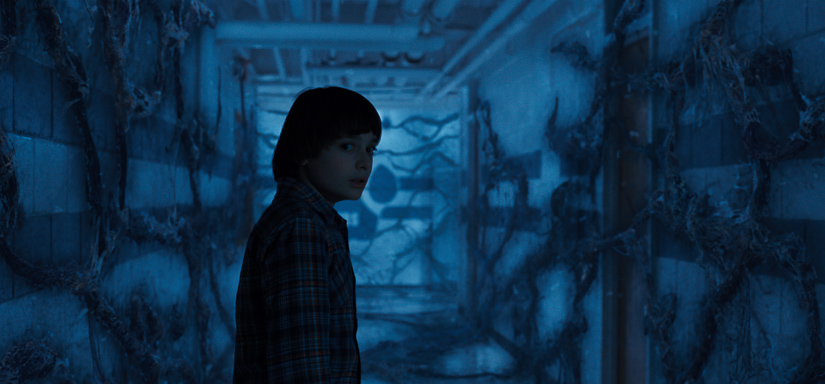
At one point the Mind Flayer’s tentacle arm is searching around for the kids, and its vocalizations sound like a Speak-n-Spell!
CH: That’s my voice doing little chittery-chattery type noises combined with the ironing board squeaks and cappuccino machine squeals that we recorded for the vines in Season 2. Those vines show up in Ep.1. So, again for me, I’m always tying in familiar sounds in the Stranger Things universe.
So, I ran some of those squealy, cappuccino-machine noise and squawks, and my chittery vocalizations and growling, gurgling sounds through different plug-ins to get it to chitter and chatter a bit.

Those were all done in an attempt to make the tentacles appear sentient, like they were the smarter part of the big monster. Those tentacle arms were the smart guys. Those were the things that were going to figure out where the kids were hiding. When they are hiding in that sporting goods store and those tentacles come around the corner, those are prime opportunities to do smart character/intellectual vocalizations for those little guys.
The great thing about that scene are the dynamics, trying to play off the big monster stuff with these quiet moments where you hear the tentacles sliding around corners and searching for the kids. Thankfully, Matt and Ross [Duffer] shot it that way and it was edited with the right pacing. It was fun to play around with those two things to make sure the storytelling was supported with what we were doing with the sound design.
[tweet_box]Behind the growing, evolving sound of Stranger Things Season 3 – with Craig Henighan, Will Files and Mark Paterson:[/tweet_box]
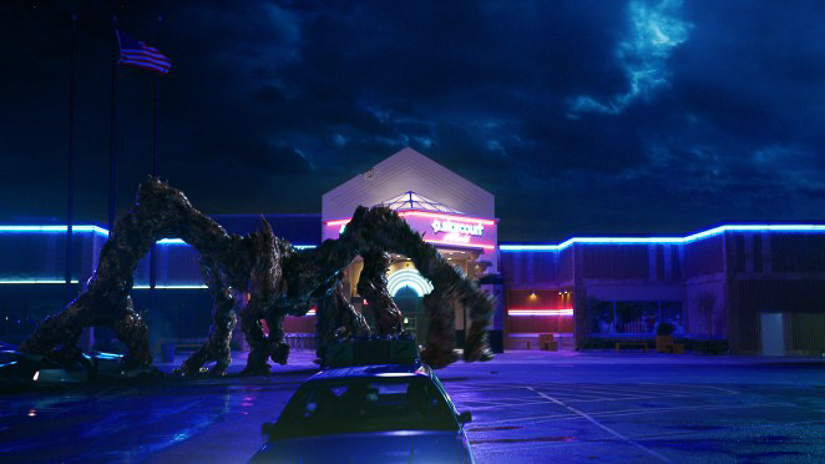
Another fun sound for that scene (when the Mind Flayer falls through the mall’s ceiling) was the smashed-up walkie-talkie. Dustin’s voice is coming through all broken–up and crackly…
MP: That was a combination of Audio Ease’s Speakerphone with EQ futzing and reverb. Also, I literally just cut holes in Dustin’s dialogue track, without fades, so you get that click where each hole happens. Sometimes the simple approach works best.
This season is definitely gorier. Can you tell me about creating those gore sounds?
CH: The gore sounds were made from a lot of raw chickens and slimy stuff from the supermarket — different types of vegetables and fruits — and messing them up. Sound Effects Editor Angelo Palazzo also did a bunch of recording and cut a lot of great gory sounds too!
I found the best way to do that was record myself in big rubber boots stomping around in mud.
I did a whole pass of mud footsteps for the monster. So, along with the giant thumps and classic monster stomping, I wanted to add a layer of gore and slime to that. I found the best way to do that was record myself in big rubber boots stomping around in mud. Last winter we had a pretty good rainy season so it was easy for me to go in the backyard and record a bunch of footsteps, muddy type sounds. That layer gave the monster an interesting footstep sound. So it was a good combination of stomps and details of mud and slime.
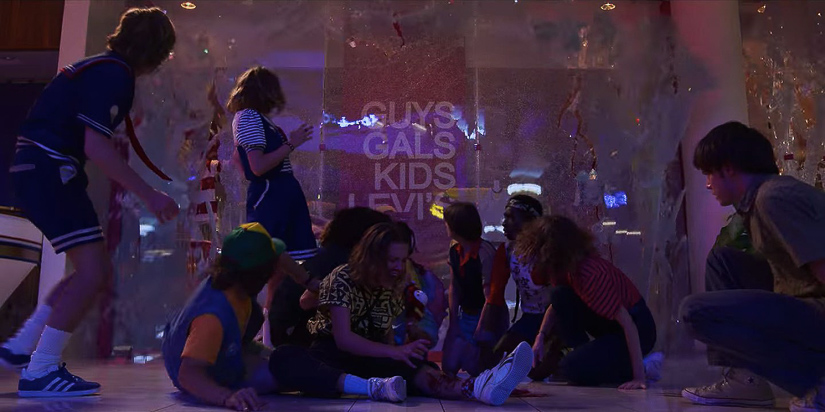
When they cut open Elle’s leg to get that wormy thing out, that was nauseating!
CH: I think that was small chicken bone breaks with some guts still on there. Some of those sounds make you jump from the performance in the recording, whether it’s raw chicken or anything that can be manipulated or performed while recording.
There were also some vocal squeals in there for the little flesh thing that jumps out of her leg. That sound was a call-back to the rats in Ep.1, which is a call-back to the vines from Season 2. It’s the idea of having those squeals and squawks feel familiar but still evolve into what they need to be for the scene.
We’ve covered the sound for all 3 seasons of Stranger Things – check out the in-depth interviews below:
• How the outstanding sound for Stranger Things is made
• Behind the thrilling sound of Stranger Things – Season 2
• Hear the story behind the sound for Stranger Things 3
Any favorite sound toys for sound design on this one?
CH: My usual suspects for this world are the Krotos stuff, Dehumaniser for sure. Eventides H3000 for a lot of pitch processing. One plug-in I used fairly often was Infected Mushroom’s Manipulator from Polyverse Music. I have a few different workflows here, with three or four different plug-ins in a chain and I’ll playback my sounds from a sampler or record live right into a chain of processing.
The Full Dustin and Suzie NeverEnding Story Scene | Stranger Things S3
Another scene I liked in Ep. 8 was Dustin and his girlfriend Suzie singing “The NeverEnding Story” song to each other…
MP: Music editor Dave Klotz was very involved in it because he had to write/record a lot of parts himself to make it work. As a talented songwriter himself, he got to dust off some of his 80’s gear. It was a fun time because I mixed the song for the soundtrack album before we mixed the episode. So that was our rehearsal run and it gave me a chance to play around with a few things and experiment. Of course, that version didn’t have all the dialogue treatments for the phone and radio perspectives.
The Music of Stranger Things (Season 2) – with Composers Kyle Dixon and Michael Stein
It was a fun time because I mixed the song for the soundtrack album before we mixed the episode.
The vocals were all production audio so, it’s all live vocal performances from the actors on set. That brings its own challenges. When you have multiple actors singing live in different locations they have to be crafted carefully to sound like they are singing the same song together. Noise, pitch and tempo are the tricky aspects and, of course, they both have to stay in sync with the picture on-screen. Split-screen in this instance, which adds an additional complication.
I decided to pan their voices in the split-screen shots, with Dustin on one side and Suzie on the other.
Then, we had to consider how much to do to make it sound like a produced song versus the vocals sounding like it’s still in the scene. What we did was establish the singing as part of the scene, and then open it out so it sounded more produced as you get into it. I toyed around with the idea of not using futz treatments even though they are on radios in the scene but in the end, it was about getting a reasonable balance and I decided to keep them in. Actually the different radio perspectives add to the humor, I think. Then I decided to pan their voices in the split-screen shots, with Dustin on one side and Suzie on the other. I think it worked out well. It feels pretty smooth where we ended up.
All the work I did on mixing the vocals and instruments for the soundtrack, I was able to use that automation as a starting point when mixing the song in the show.
CH: Dustin is a trained singer and Suzie is too. That’s the great thing about the Duffers. They write these things into the storyline, Dustin needed the code and they came up with this whole idea of how to do “The NeverEnding Story” and it’s so great.
Highlights from A Sound Effect - article continues below:
The EQ treatments were great too. You hear their singing over the ham radio and then in Hopper’s car…
MP: When it comes to that sort of processing — not just for the singing but for other dialogue too — I consider what the phones and small speakers from that period sounded like and try to replicate that. Obviously, you want to retain clarity in the words so again it’s a balance
…we end up filtering it as well. Just a classic hi-pass/low-pass filter. Because that’s 75% of what makes a futz sound like a futz.
For futzing, it was mostly Audio Ease’s Speakerphone and some reverb treatments.
WF: Even when we use Speakerphone, we end up filtering it as well. Just a classic hi-pass/low-pass filter. Because that’s 75% of what makes a futz sound like a futz. Speakerphone is great for adding a bit of distortion or resonance, or a little noise that’s modulated with the signal. The stuff it can do is really cool, but it’s also easy to go too far with it. I tend to use it as just the frosting on top and not as the main source of the futz.

What was the most challenging scene in terms of the mix on Ep. 8?
WF: It’s hard to narrow it down to just one scene because it was a really complicated episode.
I’d say the whole intercutting at the end, between the action happening in the mall and the various cars and then, when Billy shows up things get emotional. That was a hard scene because we were going from a full-on big action-type style to make it pivot and be more of an emotional moment between Billy and his sister. We had to start peeling the mix back in layers and pushing the sounds away so that it didn’t feel jarring to the audience. We had to do it in stages.
The Sound of Stranger Things 3 – with Sound Supervisor Craig Henighan, Dx and Music Mixer Mark Patterson, Music Editor David Klotz , SFX Editor Angelo Palazzo, SFX Editor Katie Halliday
MP: The scene with Billy and his sister was very emotional. It’s great to have the creature sounds, but when it’s a seven or eight minute sequence, you need to go in a few directions. It’s how we get in and out of them that was the difficult bit.
WF: A lot of it was dealing with the transitions.
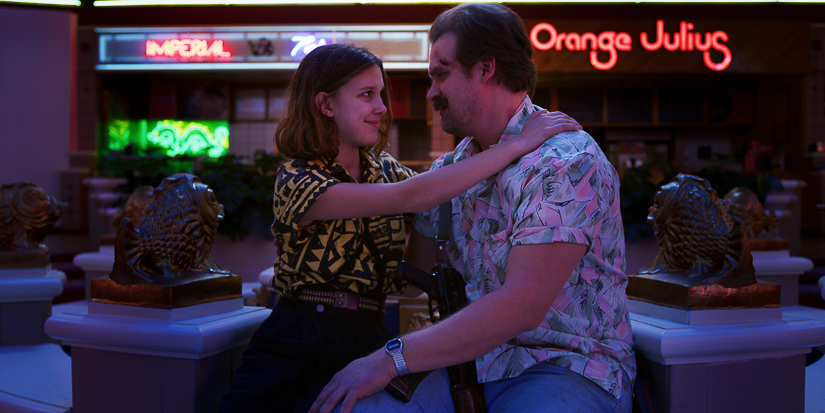
And this episode was all over the map. You had a lot of action, and some really emotional scenes, like Elle reading Hopper’s letter near the end…
WF: For that scene, many tears were shed on the mix stage. When we played it back to the Netflix executives, they were a mess. There was running mascara and boxes of Kleenex. But that’s when you know you got it right.
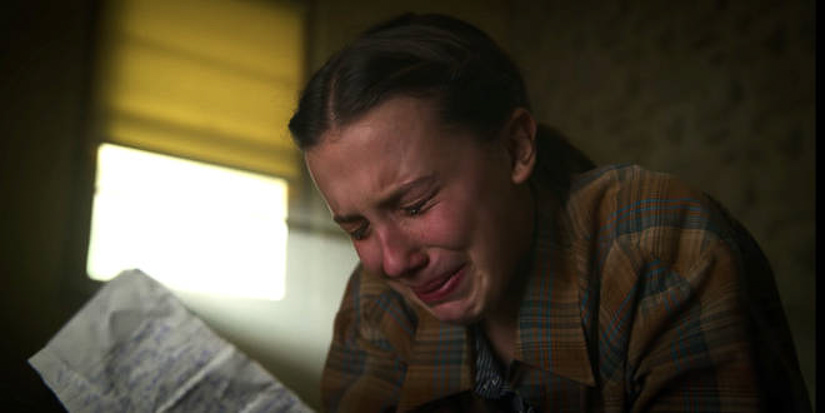
I admit, I was a mess too!
WF: Me too.
MP: When we first had it all come together, we just needed a minute after we finished.
WF: That’s what makes the show work so well, the emotional stuff. It has a lot of heart and I think that’s why it resonates for people. It has a lot of comedy and action, and the monsters are really cool and it’s scary but the reason everyone likes it so much is because it has so much heart.
That’s what makes the show work so well, the emotional stuff. It has a lot of heart and I think that’s why it resonates for people.
The Duffers are so good at taking all of those different tones and putting them together into something that feels cohesive. That was definitely an ongoing challenge for us in the mix — how do we support both big action with big sound effects and make a big cinematic sound for a TV show but then also make sure we are tracking the emotionality of the scene, leaning on the music when we need to…
MP: It’s hard for us to go too far. They love big action and so we push it is much as we can. If we go into a more emotional moment we commit 100% to that as well. They want to embrace those moments and they like that contrast between the two. How you get there — the transition as we call it — is something that Will and I like to focus on with every project we work on.
They love big action and so we push it is much as we can. If we go into a more emotional moment we commit 100% to that as well.
It’s just a thing that we find is a core part of the sound and a way we can connect scenes together. As it turned out, the Duffers understand the importance and benefit of this too. It was nice to be completely in sync with them, and to take the time to really get some cool ins-and-outs for each moment. We were all looking for unique ways to achieve them and in the end I think the transitions became one of the identities in the sound this season.
WF: They understand that sound can make something feel bigger and more impactful. There always looking for how to maximize every moment.
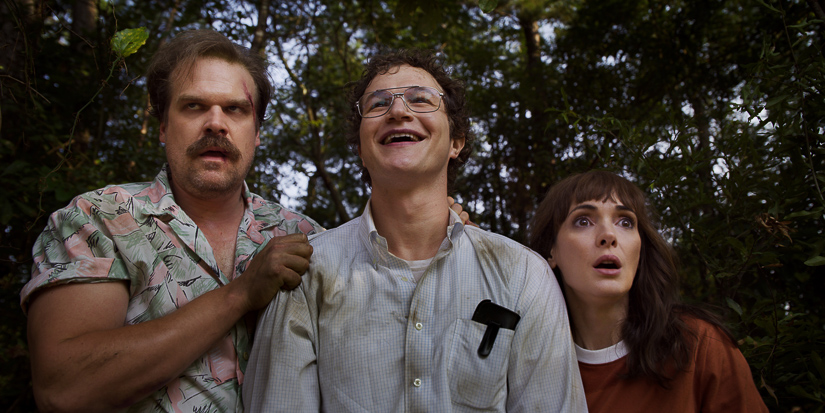
What are you most proud of in terms of sound on Stranger Things?
CH: Stranger Things is a real team effort, from the directors and producers and picture editors, vfx, music, sound design and mixing. From Production right into Post. That’s what I’m most proud of, the team effort that it takes to bring a show like this to life.
MP: I feel like we went into this with the idea of somehow making it sound like a feature on the small screen. We wanted to make sure we’d be able to do that and I think we did. We knew it would be an opportunity for sound and I think we managed to give it a style that is instantly recognizable as Stranger Things.
WF: One thing we talked about going into the season was the Duffer brothers wanted it to feel like the ’80s and ’90s movies that we grew up watching, which had really great cinematic soundtracks. It was the dawn of the era of sound for film. I think we achieved that, which is cool.
This was one of the most creatively rewarding experiences of my entire career. It was also a huge amount of fun. I hope we get to do it again.
A big thanks to Craig Henighan, Will Files, and Mark Paterson for giving us a behind-the-scenes look at the sound of Stranger Things and to Jennifer Walden for the interview!
 Tesla Model X 2015 electric full size crossover SUV sport utility vehicleKrampfstadt Studio65,00 $32,00 $51% OFF
Tesla Model X 2015 electric full size crossover SUV sport utility vehicleKrampfstadt Studio65,00 $32,00 $51% OFF


